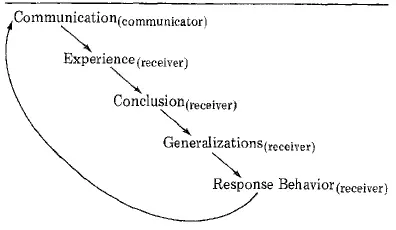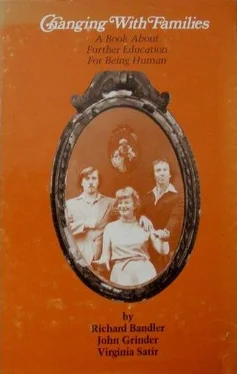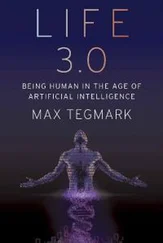It is important for us to emphasize this distinction between content and process. Our model of family therapy is designed to assist the family in coping effectively at the process level. In other words, independently of whether the members of the family believe their "problem" to be in the area of sex, or money, or child-rearing practices, in-laws, discipline, or whatever, effective family therapy will expand their choices of expressing congruent communication and of coping in every area of their experience as a family. In our work, we have found that assisting family members in having new choices at the process level in any area of content will generalize naturally to other areas of their experience. [19] This phenomenon, in which changes occur in areas of behavior not expressly dealt with in the therapeutic session, is discussed in The Magic of Patterns/The Patterns of Magic (forthcoming, Bandler and Grinder). The key concept is that of isomorphism, same-form pattern. Thus, if an individual makes a change in the area of the way he relates to his mother — that is, he gains new choices about how he relates to his mother — then, typically, he surprises himself with a change in his behavior about the way he relates to his wife, the women with whom he works at the office, etc. The specific principles by which such changes are generalized will be presented in the reference cited above.
Furthermore, our model is designed to provide each of you with a way of organizing your experience so that you have a direction, a way of knowing what happens next, not by deciding beforehand what will happen but by recognizing the patterns presented to you by the family. Perhaps most important for your continued growth as a potent family therapist, it provides you with a way of getting feedback, a way of finding out what works. Our hope is that you will accept this model and find it useful in your difficult but rewarding work as a people-helper.
We feel that it is helpful to you, the reader, in using the patterns in the model for family therapy which we have created, to have an explicit, clear understanding of the process we call communication. We would remind the reader that what we present as our model of the word communication does not completely cover either our understanding or our experience. Rather, we offer it as a guide to assist you in finding meaning in our model for family therapy. Visually, we can represent the process of communication in the following steps:

1. Communication (communicator) = the messages offered by the person doing the communicating. The person communicating will present these messages in many different forms — body postures; movement of hands, arms,etc.; eye-scanning patterns; voice tonality and tempo; breathing rate; words, sentence syntax, etc. Furthermore, these messages may or may not be in the conscious awareness of the person communicating.
2. Experience (receiver) = the messages received by the person to whom the communication is directed. The messages are received through the various sensory channels: eyes, ears, skin, etc. These messages may or may not be in the conscious awareness of the person receiving them.
3. Conclusion (receiver) = the understanding reached by the person receiving the messages as to what the messages mean. Again, the receiver may reach an understanding both in and out of conscious awareness.
4. Generalization (receiver) = the way in which the person receiving the messages connects them with his past experience, and the way in which the receiver uses his understanding of the messages received to shape his comprehensions and responses explain their use in the present and, without intervention, for the future.
5. Response Behavior (receiver) = the way in which the person receiving the messages responds. This step in the communication cycle is equivalent to the first step when the original communicator and receiver have switched positions. In the diagram on page 98, this is the meaning of the arrow which cycles back, connecting the last step in the diagram to the first step.
In our experience, the process of communication between two or more people rarely occurs in this sequence; rather, the steps typically overlap. For example, even as I arrange my body in a certain posture, move my hands and feet and eyes, produce a certain tone of voice, speak at a specific speed, utter the specific words in the specific sentence forms, I see movements as you shift your body posture, move your hands, nod or shake your head, etc. — movements which present messages to me which I incorporate (both in and out of awareness) into my ongoing communication. Thus, as with any model which we create, we have made discrete and separate the ongoing flow of experience in order to attempt to fully understand all of the messages and to create new choices for ourselves.
As family therapists, one way for us to understand the task which we have set for ourselves is to assist the families who come to us in pain to create new choices for themselves, both as individuals and as a family unit. The family's pain becomes for the therapist a signal for a powerful intervention for change. Pain, therefore, is in itself a useful message. We interpret it as a wish to grow in an area in which the person needs help to achieve that growth. More specifically, we work to discover the needs and to help the family members change the patterns of communication by which they are creating this pain for themselves. Using the previously given, five-step model for communication, we ask how we can train ourselves to be more skillfull in discovering the patterns which are causing the family pain, and how we can re-organize the family's resources so as to transform the patterns of pain into patterns of positive communication which each family member can use to gain what he or she wants. Another way of stating this is to ask: What are the characteristics of the patterns of miscommunication in families; by what particular process are they created; and how, specifically, can we intervene in the family system to help the members transform the patterns of miscommunication into resources for themselves? To answer these questions, we will describe two extreme patterns of communication — the pattern of calibrated communication, which results in pain and dissatisfaction for the people involved, and the pattern of feedback communication, which results in choices for the people involved. Whether the communication is congruent or incongruent, the process of communication will continue — in both cases, each of us acts and reacts. Typically, the way we act in the context of incongruent communication is untimely, inappropriate, and chaotic, while, in the context of congruent communication, we act timely, creatively, and appropriately to the occasion.
CALIBRATED COMMUNICATION CYCLE
We now describe the specific characteristics of a typical calibrated communication cycle [20] Calibrated communication, as with all of the processes of communication, is not an inherently bad or pain-producing process. It is the basis for close teamwork, whether in the context of co-therapy, ballet, team sporting events, etc. However, just as with each communication and modeling principle of which we are aware, such calibrated communication processes must be checked for their usefulness. When these processes lead to pain and dissatisfaction for the family, they must be reexamined and new choices must be developed. Gregory Bateson presents an excellent discussion of the differences between feedback and calibration in his article, "The Bio-social Integration of Behavior in the Schizophrenic Family," in Therapy, Communication and Change, D. D. Jackson (ed.), Volume II; Science and Behavior Books, 1968, pp. 9-15.
which results in pain for the people involved. We use the five-step communication model.
Читать дальше












